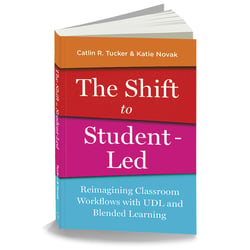How do you know if you are leading a teacher-led or a student-led classroom?
Let's start with a quiz:I am fully responsible for the design of instruction and the transfer of information to my students
A. True
B. False
I set the pace of my students' reading
A. True
B. False
I am the only person who sees/provides feedback on my students' assignments
A. True
B. False
Prior to an assessment, I provide my students with review materials and activities (such as study guides, review questions, games, etc.).
A. True
B. False
If you answered mostly A's - then I am sorry to tell you that you are spending too much time and energy doing things for students that they are fully capable of doing themselves. Read: You’re probably exhausted and overwhelmed. But don't worry - you are not alone and we’re here to help!
The last few years have taken a toll on teachers. Many of the teachers that I work with express frustration with the profession. They are drowning in work and in unrealistic expectations. This work is emotionally and mentally exhausting. Frankly, what I have experienced again and again is that teachers are working too hard to not see results.
So what is the solution? Making the shift from a Teacher-Led classroom to a Student-Led classroom! I have teamed up with Blended Learning queen, Catlin R. Tucker, to reimagine ten time-consuming traditional classroom workflows. Throughout The Shift to Student-Led, we share strategies on how to transform teacher-led workflows to a student-led approach that will lead to sustainable and rewarding results:
1. From Transfer of Information to Student Discovery2. From Whole-Group Teacher-Led to Small-Group Student-Led Discussion
3. From Reading as Solitary Endeavor to Reading for Connection
4. From an Audience of One to an Authentic Audience
5. From Teacher-Created to Student-Generated Review and Practice
6. From Formative Assessment as Teacher Tool to a Metacognitive Tool for Learners
7. From Feedback on Finished Products to Feedback during the Process
8. From Teacher Assessment to Self-Assessment
9. From Teachers Initiating Parent Communication to Learners Owning the Conversation About Their Progress
10. From Teacher Project Design to Student-Initiated Project-Based Learning
In writing this book, we set out to accomplish two goals:
- For students to develop into expert learners capable of sharing ownership of learning, so teachers are not doing the lion’s share of the work.
- For teachers to rediscover their joy and reengage in this profession.
The ten workflows are fundamental shifts in the way we think about our role and the role of students in the learning process. You may worry that students are not capable of sharing the responsibility of learning; however, that fear is an indication that students need more, not fewer, opportunities to fully engage in the learning process.
We hope you join us and make the shift!

Get your copy of The Shift to Student-Led, download the book club guide, get your colleagues on board, and spark conversations about how universally designed blended learning can help teachers create more sustainable approaches to this work.



